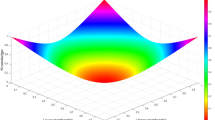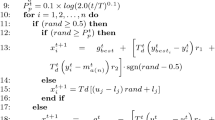Abstract
This paper presents further investigations with a fuzzy genetic method for the generation of fuzzy rule bases using improved preprocessing conditions. This method, previously proposed by the authors, uses the degree of coverage of candidate rules to select the ones forming the search space of the genetic algorithm, thus it is named DOC-BASED method. For this particular fuzzy genetic method, a previous attribute selection might be necessary. The definition of the fuzzy data base can also impact the results of the automatic generation of rule bases. To this end, an heuristic method for database definition, FUZZY-DBD and an attribute selection method, FUZZY-WRAPPER, were previously proposed and investigated in different contexts by the authors. The goal of this paper is to propose and investigate an enhanced version of the DOC-BASED method, regarding time reduction for the genetic search space generation, combined with the FUZZY-DBD and the FUZZY-WRAPPER methods for the database definition and attribute selection process. The methods used are described and the advantages of the enhanced version of the DOC-BASED method is discussed. Experiments were performed aiming at comparing results generated by the original plain DOC-BASED method and its extended version described here. The experiments also include studies using a filter-based attribute selection method. Experimental results on 10 datasets are presented and compared. Results show that a fuzzy approach to attribute selection and their proper fuzzification can yield significant improvements to rules generation.



Similar content being viewed by others
References
Alcalá R, Alcalá-Fdez J, Gacto M, Herrera F (2007) Genetic learning of membership functions for mining fuzzy association rules. IEEE Int Conf Fuzzy Syst 1:1538–1543
Asuncion A, Newman D (2007) UCI machine learning repository. http://www.ics.uci.edu/∼mlearn/MLRepository.html
Casillas J, Cordón O, Jesus M, Herrera F (2005) Genetic tuning of fuzzy rule deep structures preserving interpretability and its interaction with fuzzy rule set reduction. IEEE Trans Fuzzy Syst 13:13–29
Castellano G, Castiello C, Fanelli A, Mencar C (2005) Knowledge discovery by a neuro-fuzzy modeling framework. Fuzzy Sets Syst 149:187–207
Castro PAD, Camargo HA (2005) Focusing on interpretability and accuracy of genetic fuzzy systems. IEEE Int Conf Fuzzy Syst 1:696–701
Chen MS, Wang SW (1999) Fuzzy clustering analysis for optimizing membership functions. Fuzzy Sets Syst 103:239–254
Cheng HD, Chen JR (1997) Automatically determine the membership function based on the maximum entropy principle. Inf Sci 96(3–4):163–182
Cintra ME (2007) Genetic generation of fuzzy rules with preselection of candidate rules. Master’s thesis, Federal University of Spo Carlos
Cintra ME, Camargo HA (2007a) Fuzzy rules generation using genetic algorithms with self-adaptive selection. In: IEEE international conference on information reuse and integration, IRI, pp 261–266
Cintra ME, Camargo HA (2007b) Genetic generation of fuzzy rules with pre-selection of candidate rules. VI Encontro Nacional de InteligOncia Artificial 1:1341–1350 (in Portuguese)
Cintra ME, de Arruda Camargo H, Monard MC (2008) Fuzzy feature subset selection using the Wang & Mendel method. Hybrid Intell Syst 1:590–595
Cintra ME, Camargo HA, Martin TP (2009a) Optimising the fuzzy granulation of attribute domains. In: International Fuzzy Systems Association World Conference, pp 742–747
Cintra ME, Martin TP, Monard MC, Camargo HA (2009b) Feature subset selection using a fuzzy method. Int Conf Intell Hum Mach Syst Cybern 2:214–217
Cordón O, Gomide FAC, Herrera F, Hoffmann F, Magdalena L (2004) Ten years of genetic fuzzy systems: current framework and new trends. Fuzzy Sets Syst 141(1):5–31
Cordón O, Alcalá R, Alcalá-Fdez J, Rojas I (2007) Special section on genetic fuzzy systems. IEEE Trans Fuzzy Syst 15:533–592
Cordon O, del Jesus MJ, Herrera F (1999) A proposal on reasoning methods in fuzzy rule-based classification systems. Int J Approx Reason 20(1):21–45
Demšar J (2006) Statistical comparison of classifiers over multiple data sets. J Mach Learn Res 7(1):1–30
Dou W, Ren Y, Wu Q, Ruan S, Chen Y, Bloyet D, Constans JM (2007) Fuzzy kappa for the agreement measure of fuzzy classifications. Neurocomputing 70(4-6):726–734
Dumitrescu D, Lazzerini B, Jair L (2000) Fuzzy sets and their application to clustering and training. International Series on Computational Intelligence, CRC Press, Boca Raton
Dunn J (1973) A fuzzy relative of the isodata process and its use in detecting compact well-separated clusters. J Cybern 3(4):32–57
Hall MA (2000) Correlation-based feature selection for discrete and numeric class Machine Learning. In: Proceedings of the 17th International Conference on Machine Learning, Morgan Kaufmann, pp 359–366
Hoffmann F (2004) Combining boosting and evolutionary algorithms for learning of fuzzy classification rules. Fuzzy Sets Syst 141:47–58
Holte RC (1993) Very simple classification rules perform well on most commonly used datasets. Machine Learn 11(1):63–90
Hong TP, Chen CH, Wu YL, Lee YC (2004) Using divide-and-conquer GA strategy in fuzzy data mining. In: Proceedings of the 9th international symposium on computers and communications (ISCC’04), vol 2, pp 116–121
Hong TP, Chen CH, Wu YL, Lee YC (2006) A GA-based fuzzy mining approach to achieve a trade-off between number of rules and suitability of membership functions. Soft Comput 10(11):1091–1101
Ishibuchi H, Nojima Y (2006) Evolutionary multiobjective optimization for the design of fuzzy rule-based ensemble classifiers. Int J Hybrid Intell Syst 3:129–145
Jang SR, Sun CT, Mizutani E (1997) Neuro-fuzzy and soft computing. Prentice Hall
Jun AJJ, Bai MM (1989) Effects of misspecification in estimating the percentiles of some two- & three-parameter distributions. ANU, Australia
Kaya M, Alhajj R (2003) A clustering algorithm with genetically optimized membership functions for fuzzy association rules mining. In: 12th IEEE International Conference on Fuzzy Systems, vol 2, pp 881–886
Kaya M, Alhajj R (2004) Integrating multi-objective genetic algorithms into clustering for fuzzy association rules mining. In: ICDM’04: Proceedings of the fourth IEEE international conference on data mining, IEEE Computer Society, pp 431–434
Liao TW, Celmins AK, Hammell RJ (1997) A fuzzy C-Means variant for the generation of fuzzy term sets. Fuzzy Sets Fuzzy Syst 135:241–257
Liao TW, Celmins AK, Hammell RJ (2001) A fuzzy c-means variant for the generation of fuzzy term sets. Fuzzy Sets Syst 135:241–257
Manley-Cooke P, Razaz M (2007) An efficient approach for reduction of membership functions and rules in fuzzy systems. In: Fuzzy systems conference, FUZZ-IEEE, vol 1, pp 1609–1613
Medasani S, Kim J, Krishnapuram R (1998) An overview of membership function generation techniques for pattern recognition. Int J Approx Reason 19:391–417
Pedrycz W (1996) Fuzzy modelling: paradigms and practice. Kluwer Academic Press, Dordrecht
Pires MG, Camargo HC (2004) Genetic learning and optimization of fuzzy sets in fuzzy rule-based systems. IEEE Int Conf Inf Reuse Integr 44:623–628
Wang L (2003) The WM method completed: a flexible fuzzy system approach to data mining. IEEE Int Conf Fuzzy Syst 11:768–782
Witten IH, Frank E (2005) Data mining: practical machine learning tools and techniques with Java implementations, 2nd edn. Morgan Kaufmann
Yu L, Liu H (2004) Efficient feature selection via analysis of relevance and redundancy. J Mach Learn Res 5:1205–1224
Author information
Authors and Affiliations
Corresponding author
Rights and permissions
About this article
Cite this article
Cintra, M.E., Monard, M.C. & Camargo, H.A. Data base definition and feature selection for the genetic generation of fuzzy rule bases. Evolving Systems 1, 241–252 (2010). https://doi.org/10.1007/s12530-010-9018-6
Received:
Accepted:
Published:
Issue Date:
DOI: https://doi.org/10.1007/s12530-010-9018-6




